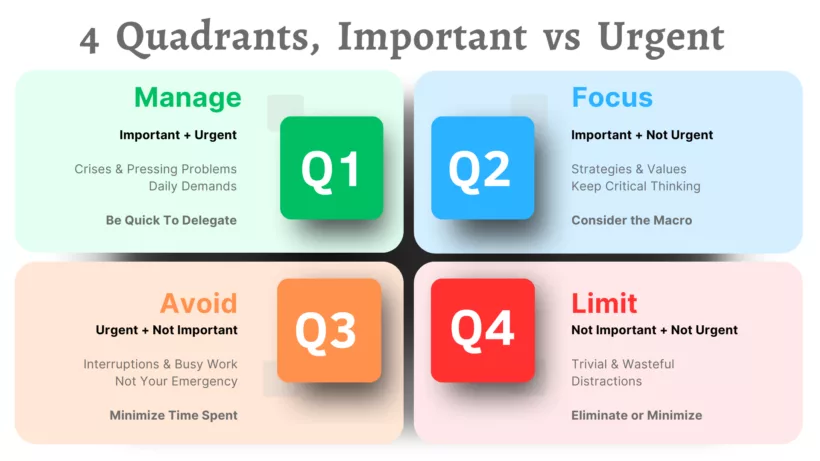What is First Priority Management?
First priority management helps leaders identify, evaluate and line up tasks and goals based on their importance. It involves specifying the most crucial assignments or projects that must be accomplished first, setting clear goals and timelines for them, and allocating resources accordingly. With first priority management, leaders can make informed decisions about what is most important, what can be delegated, and what can be delayed or eliminated.
Why is First Priority Management Important?
The technique of priority management holds significance as it avoids constant firefighting in a team. Instead, it encourages triaging tasks and managing workloads effectively. Prioritization aligns the team with business goals and helps to keep the projects on track. It enables visualization of the project by scheduling duties with designated time slots, which aids in meeting the project’s deadlines. Effective prioritization also promotes teamwork and work/life balance by ensuring that urgent tasks are shared amongst the team, making the team more cohesive and productive.
Why is First Priority Management Useful for All Employees and Executives?
First priority management is useful for all employees because it helps them make informed decisions about what to focus on to achieve the organization’s objectives. It ensures that everyone is aligned and working towards the same goals, which can increase efficiency and productivity.
In the context of executives, first priority management is essential because they are responsible for setting the tone for the rest of the organization. If executives prioritize effectively, it can lead to better resources, increased productivity, and not missing opportunities. It also helps leaders manage their time and resources effectively and delegate to the appropriate people. Prioritizing the right jobs and goals can also lead to increased profitability, better employee morale, and overall success for the organization.
How First Priority Management Can Impact Businesses
First priority management can have a significant impact on businesses in several ways. It can help organizations meet their objectives, reduce costs, increase efficiency, and improve overall performance quickly. It can also help companies to identify and eliminate unnecessary jobs and goals, reducing costs and increasing profitability. Companies can focus their resources on the areas most likely to generate the highest returns by prioritizing the most critical tasks and goals.
What Can Go Wrong Without First Priority Management?
With first priority management, businesses can avoid falling into the trap of focusing on the wrong areas, leading to decreased productivity, missed opportunities, and increased costs. It can also lead to employee burnout and reduced morale, as employees may feel like they are working on responsibilities that are not contributing to the organization’s objectives. Additionally, organizations may miss out on opportunities to innovate and grow without first priority management, as they may not be focused on the right areas.
Quick Tips for First Priority Management
Here are some tips for first priority management:
- Set clear goals: Make sure you have clearly defined goals and objectives for yourself and your team. This will help you rank your duties and stay focused on what’s most important.
- Prioritize tasks: Once your goals are set, prioritize them based on their importance and urgency (see more below). This will help you stay on track and focus on the most critical assignments first.
- Use a to-do list: A to-do list can be an excellent tool for staying organized. Ensure you update your list regularly and cross off items as you complete them.
- Avoid multitasking: Multitasking can be tempting, but there are more effective ways to manage your time. Instead, focus on one thing at a time and give it your full attention.
- Learn to delegate: Delegation is essential for first priority management. Ensure you delegate to the right people and provide clear instructions and expectations.
- Take breaks: Taking regular breathers can help you stay focused and avoid burnout. Make sure you’re taking pauses throughout the day to recharge and refocus.
- Review and adjust: Regularly review your priorities and adjust as needed.
Importance and Urgency
For 27 years, enterprise workers have widely circulated and implemented Steven Covey’s seven famous habits. However, even with these tried-and-true principles, it’s essential to be reminded of their effectiveness.
Covey proposed a system of dividing work into four quadrants:
- Important and Urgent
- Important and Not Urgent
- Not Important and Urgent
- Not Important and Not Urgent

Unfortunately, many people tend to spend too much time in quadrant three, Not Important and Urgent. This is mainly due to the ease of identifying urgency, while other factors are more subjective. To ensure your team is productive, creating a priorities management system that prioritizes quadrants one and two and limits time spent in quadrant four is crucial.
Implementing First Priority Management Training
Training is an essential component of implementing first priority management within an organization. Leaders need to be trained to identify and evaluate the most important responsibilities and goals and make informed decisions about prioritizing them. Additionally, all employees must understand the organization’s objectives and how their work contributes to achieving them.
First priority management training can be delivered through various methods, including workshops, online courses, and coaching sessions. It is essential to tailor the training to the organization’s specific needs and ensure that it is integrated into the organization’s overall culture and values.
Ready to Prioritize Like a Pro? Let’s Get Started Today!
Arden Coaching offers several training programs with first priority training embedded in to help your organization develop the skills to prioritize tasks and goals. Contact us today to learn how we can help your organization achieve its objectives through first priority management.

